Ever since we came back from Kumra Parvata trek (7-8 November 2009, http://balutreks-balachandra.blogspot.com/2011/05/kumaraparvata-eventful-trek.html) myself and Giri (Sheshagiri Gaonkar) were wondering about going their again and finish our unfinished task of reaching the peak. This came true only during the weekend of 14 and 15 May 2011. Eleven of us (Giri, Vinay, Rane, Mahesh, Samit, Vijender, Vishwas, Gowtham, Chaitanya, Chandan and I) trekked Kumara Parvata on that week end. Five of us were going there for second time and six were new. Kumara Parvata is a part of Western Ghats situated at the border of Dakshina Kannada and Kodagu districts Shivamogga districts, between the famous pilgrimage Kukke Subramanya and Somavarapete. The peak is about 1712 meters high and arguably the most popular as well as most strenuous trekking spot in Karnataka.
This time we approached it from Somavarpete in Kodagu district. The peak is 13 Kms from Subramanya and 9 Kms from Somvarpete. Though the later route is nearer, it is relatively tougher and highly infested with leeches. Our advice to trekkers is to avoid this route in wet seasons. The leeches attack in dozens at a time, making it difficult to tackle them through the known means of using salt and lime.
I had dehydration on Friday and was reluctant to go, but decided not to pull out in the last minute. We had decided to carry 2 litres of water each (not enough!), bread, jam, fruits, torch, shawl, medicines and most importantly electral.
We left for Somavarpete on 13th night at 10 pm by a Force traveller. We reached Somvarpete around 5 am on Saturday, freshened up at Udaya lodge in the town centre, had a good breakfast of idli and pulav, and proceeded to Beedhalli. We reached Beedhalli at 7.45 am where we took some photos at the starting point and started our trek at 8 am. There is a Shanti Malleswara temple here, but we didn’t visit it. It was cool in the morning and a lovely weather. We had heard that it had rained few days before there, and hoping not to get caught in the rain again. After about half an hour, we reached the forest office where we paid the entry fee of Rs 200 each. After a few minutes, we got a bridge across Lingada Hole (with very little water) but were advised by the forest department not to use the bridge as it was weak. The trail was very scenic, but as we walked about a kilometre, we had to face the terrain with lots of leeches and it continued like that for the whole stretch. Though we had carried salt and lime (chuna), we couldn't avoid getting bitten by dozens of leeches. We also noticed that the three of us who wore Woodland leather shoes attracted more leeches that the others with synthetic sports shoes.
The trek all through to the top was very picturesque and we could see some amazing scenes with clouds kissing the hills. We took one short break half way through on a large rock where we ate some fruits. It was very cool, but as we approached the top, there were the giant mosquitoes that started attacking us. We reached the top at 12pm (4 hours), thanks to the increased pace to escape from the leeches 😊
There is a small temple on top with shivalinga in it. It goes without saying that lord shiva likes heights!
It was food time for us, though we were not feeling all that hungry. Although the original idea was to carry only bread and jam, many of us had brought delicious food. Vinay had brought masala chapattis with chatni powder and also yummy til ka laddus. Mahesh had brought boiled eggs; Vishwas had got rice with gojju etc. We enjoyed the food while fighting with the giant mosquitoes (fortunately there were no leeches here) taking care not to litter the place. It was also heartening that compared to last time; the whole trail was much cleaner.
The view from top was breathtaking. There was a view point called Marigundi Halla. After spending about an hour and a half there, we started descending towards Subramanya. Some people who had visited earlier have left directions for Giri gadde, where “Bhatra mane” is. Giri gadde is 7 kms from the Kumara parvata peak. In about half an hour’s time, we reached a place between the Kumara parvata and Shesha parvata peaks in the Pushpagiri mountain range where we recognised the place we had got caught in rain during our last trek and had to go back. We spent some time there narrating our story of horror to the new members of the team.
The descent to Giri gadde didn’t have as many leeches as the other route, it didn’t have as much tree cover and the weather was humid. We had run out of water and were getting dehydrated. That is when we reached the ‘Mantapa’ near which there was a lovely water source. This was a savoir! We quenched our thirst, filled out water bottled with the amazingly sweet, cool water and preceded to Bhatra mane at Giri gadde. We spent some time on the way at the resting spot with chairs (created by forest dept?) and took some pictures. It was 5.30 pm when we reached Bhatra mane. Some of us took refreshing cold water bath.
Bhatra mane at Giri gadde is an amazing place and Bhatru (Mr Narayana Bhat) is a very unique human being. He is a 53 years old man whose family resides in Kukke Subtramanya town. He lives in this house with an old ‘ajji’ and his cattle. Bhatru is highly hospitable and has a great sense of humour. It really requires guts to stay in a place like Giri gadde where you cannot reach by any other means than climbing the hill for 6 kms! He has many varieties of fruits and flowers in his farm. He climbed the trees to get us Pannerale (rose apple) and Mangoes. When we reached his place he was splitting wood. Then it started raining and he went searching for his cattle in the jungle. He came back and made tea for us using fresh cow’s milk.
Food was served at 9 pm as Bhatru had to go in search of one more missing cow. This could arguably be the best dinner one can get. Essentially rice, Mangaluru southekai sambar, mango pickle and butter milk, but the taste is unparalleled. We ate to our content and had a sound sleep on the foam mats provided. There were few other guest s also. Next morning some of us went in search of the elusive sun rise and rest of us took a tour of baht’s farm. The breakfast (Uppittu) was delicious and sumptuous. We started descending at 8.15 am and reached the bottom (Forest office at Subramanya town) by 10.15 am. There were few leeches on the way, but nothing compared to the earlier day. We couldn’t reach our driver over phone and five of us could get in a return auto, three of got drooped by a passing car and three had to walk to the temple. We had darshan, had lunch at kumra krupa restaurant and started for Bangalore. Within few minutes, we saw a waterfall on the way and couldn’t resist taking bath there. That was really refreshing and came as a surprise.
Though I am now nursing wounds that happened due to leech bites, the satisfaction of completing Kumaraparvata trek is highly motivating and inspiring to take up tough tasks.
Kumaraparvata is a trekker’s dream, but friends, avoid using the leech infested Somvarpet route.
Balachandra Bandodkar



















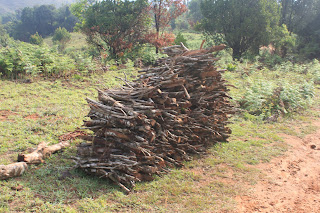


















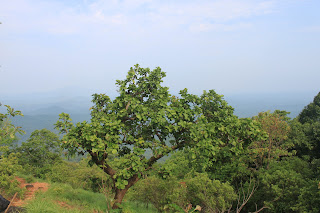







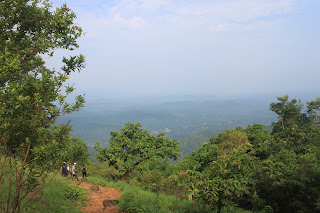






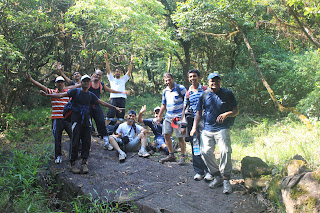
























































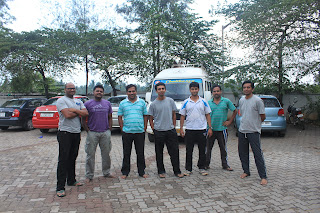
No comments:
Post a Comment